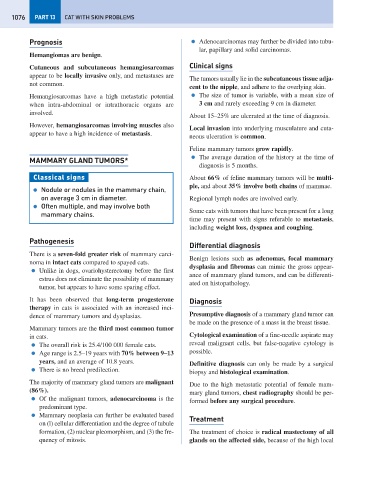Page 1084 - Problem-Based Feline Medicine
P. 1084
1076 PART 13 CAT WITH SKIN PROBLEMS
Prognosis ● Adenocarcinomas may further be divided into tubu-
lar, papillary and solid carcinomas.
Hemangiomas are benign.
Cutaneous and subcutaneous hemangiosarcomas Clinical signs
appear to be locally invasive only, and metastases are
The tumors usually lie in the subcutaneous tissue adja-
not common.
cent to the nipple, and adhere to the overlying skin.
Hemangiosarcomas have a high metastatic potential ● The size of tumor is variable, with a mean size of
when intra-abdominal or intrathoracic organs are 3cm and rarely exceeding 9 cm in diameter.
involved.
About 15–25% are ulcerated at the time of diagnosis.
However, hemangiosarcomas involving muscles also
Local invasion into underlying musculature and cuta-
appear to have a high incidence of metastasis.
neous ulceration is common.
Feline mammary tumors grow rapidly.
● The average duration of the history at the time of
MAMMARY GLAND TUMORS*
diagnosis is 5 months.
Classical signs About 66% of feline mammary tumors will be multi-
ple, and about 35% involve both chains of mammae.
● Nodule or nodules in the mammary chain,
on average 3 cm in diameter. Regional lymph nodes are involved early.
● Often multiple, and may involve both
Some cats with tumors that have been present for a long
mammary chains.
time may present with signs referable to metastasis,
including weight loss, dyspnea and coughing.
Pathogenesis
Differential diagnosis
There is a seven-fold greater risk of mammary carci-
Benign lesions such as adenomas, focal mammary
noma in intact cats compared to spayed cats.
dysplasia and fibromas can mimic the gross appear-
● Unlike in dogs, ovariohysterectomy before the first
ance of mammary gland tumors, and can be differenti-
estrus does not eliminate the possibility of mammary
ated on histopathology.
tumor, but appears to have some sparing effect.
It has been observed that long-term progesterone Diagnosis
therapy in cats is associated with an increased inci-
dence of mammary tumors and dysplasias. Presumptive diagnosis of a mammary gland tumor can
be made on the presence of a mass in the breast tissue.
Mammary tumors are the third most common tumor
in cats. Cytological examination of a fine-needle aspirate may
● The overall risk is 25.4/100 000 female cats. reveal malignant cells, but false-negative cytology is
● Age range is 2.5–19 years with 70% between 9–13 possible.
years, and an average of 10.8 years. Definitive diagnosis can only be made by a surgical
● There is no breed predilection.
biopsy and histological examination.
The majority of mammary gland tumors are malignant Due to the high metastatic potential of female mam-
(86%). mary gland tumors, chest radiography should be per-
● Of the malignant tumors, adenocarcinoma is the
formed before any surgical procedure.
predominant type.
● Mammary neoplasia can further be evaluated based
Treatment
on (l) cellular differentiation and the degree of tubule
formation, (2) nuclear pleomorphism, and (3) the fre- The treatment of choice is radical mastectomy of all
quency of mitosis. glands on the affected side, because of the high local

